Have you ever had a job that wasn't working out? Ever find yourself receiving a PIP?
It's more common than you may think.
We all have that job where something just isn't right; the role isn't what you expected, your manager set you up to fail, or you're just straight miserable. And that's when you get a PIP.
Yet it doesn't have to be a death sentence, which is why we have a post today surviving PIPs, new data from Gallup, and more.
Let’s dive in…
Table of contents:
- 🥘 Food for Thought on When you don't need 1 on 1s
- 📰 News & Reports for Managers on the Latest numbers from Gallup
- ❓ How you can help
Note: This is a preview of our weekly leadership newsletter, Lighthouse Leadership Weekly (LLW).
To get this sent to your inbox every week, along with our latest long form essays on this blog, you can sign up here.
🥘 Food for Thought
"I don't have to do career coaching, they're all fabulously happy and they know what they're doing. They're experts in their field.
...so those "one on ones" are really not necessary.
And if there's a strategic direction, why do you tell one person?
You tell everybody.
And so after we're swimming in the soup of strategizing and how to formulate the path to the future,when the time comes, I send it out to everybody at the same time....and people will give me feedback and we'll refine it.
And because the company is so flat, and you've empowered the organization so much with knowledge of the company and their access to information, the company is also agile.
Jensen Huang, CEO, NVidia
And so it turns out that by having a lot of direct reports, not having one on ones, made the company flat, information travels quickly, employees empowered, which made it possible for me not to do one on ones."
Since we talked about Jensen Huang as a great example last week, it's fitting we have another quote on his leadership style to look at this week.
Here's the video:
Leadership, Jensen Huang style! #nvidia pic.twitter.com/0ulgKDSL5W
— 🇺🇦Evan Kirstel #B2B #TechFluencer (@EvanKirstel) March 2, 2024
Does Jensen need 1 on 1s?
One of the things you learn as you master a skill is learning the exceptions to the rules.
While a lot of people on Twitter were using Jensen's quote to say they don't need one on ones, they were showing a poor understanding of why Jensen doesn't need one on ones.
Let's break down the unique circumstances:
- He's the CEO: As CEO, you're the leader of your company, and at the scale of NVidia, that means Jensen has only executives reporting to them. They're less likely to need 1 on 1s based on this.
- His team members are late in their career: Look at the executive team. These are mature adults who have worked for decades. They are unlikely to create a lot of drama, likely have tame personal lives, and won't cause or experience serious issues that your average line manager deals with.
- His team members have no need for growth: If you're an executive at NVidia, you've already won. There's no real place to advance in your career beyond already being the EVP of your department, and your stock options likely make you worth millions of dollars.
- Executives tend to have coaches: A key part of one on ones is coaching, but a CEO of a publicly traded company has no time for coaching their people (this is true even at startups). The good news is that at that level and NVidia's size, executives usually have their own coaches, which then relieves that need, and also gives them an outlet to talk to someone about work problems.
Knowing these 4 things, it should be a lot more apparent why Jensen doesn't need to have one on ones with his executives.
However, it should also be apparent that many of those do not apply to you and your situation.
Do YOU need 1 on 1s?
Group meetings and what you can cover in private, individually are two different things. 1 on 1s aren’t for status and project updates; they’re for all the things important to your team personally and individually.
Now, there are occasions slightly different from Jensen's, where you may be able to have less frequent, or no one on ones at all. I don't recommend it, but it's reasonable to understand the nuance.
Here's the factors to look for:
- High Trust: If you have a long standing relationship with a team member, then it's likely you'll have few issues working together, so you don't need to talk about them in a one on one.
- No Career Growth: If your team member already is great at their job and doesn't want to advance, then career conversations are unnecessary as well.
- Strong Relationships: If your team member works very well with you and your peers, and your whole team has that dynamic (congrats if you've built that!), then you won't need to sort out interpersonal dynamics which often require the deft, private touch of one on ones to address.
- Strong Outlets: Whether they have a coach of their own, or they trust you so deeply you know they'll come to you on their own outside one on ones, you need to make sure your team members have outlets to replace how one on ones would do that.
If you have extremely high trust, a long standing relationship with everyone, they don’t want to advance or change jobs, and your team works together extremely well, then you can check in much less often.
Yet, when any of that list isn’t true, you need one on ones as an outlet/pressure relief valve/place for all the things you don’t get around to talking about otherwise that matter to them.
---
This is a more advanced topic, so if you're confused by this nuance, start with the fundamentals of why once a month is not enough for your 1 on 1s, and then please reply with any followup questions you have.
📰 News & Reports for Managers
📌 How has Gallup's main indicators for managers changed in 2023/2024?
As we've discussed many times, Gallup tracks some really interesting data about employee engagement and the workplace.
I was surfing their site the other night and they had some interesting updates to numbers they've tracked for decades.
With that in mind, here's a rundown of some of the most interesting charts: (See all of them here)
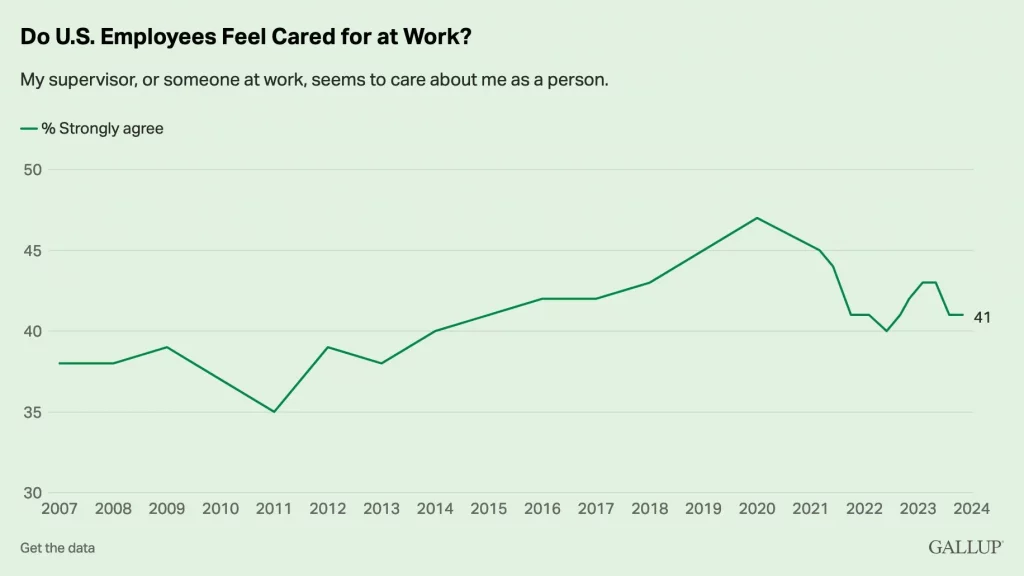
While it's ranged from roughly 35-45% over the last 15+ years, you can see the trend post-COVID lockdowns has plateaued around the middle of the range.
From a manager's perspective, this shows that if you even do the bare minimum of showing you care about your employees, you're already in the top 50% of managers.
If you want to show care for your team, it starts by building rapport. Learn over 100 ways to build rapport here, and why experts agree it's so foundational to leadership.
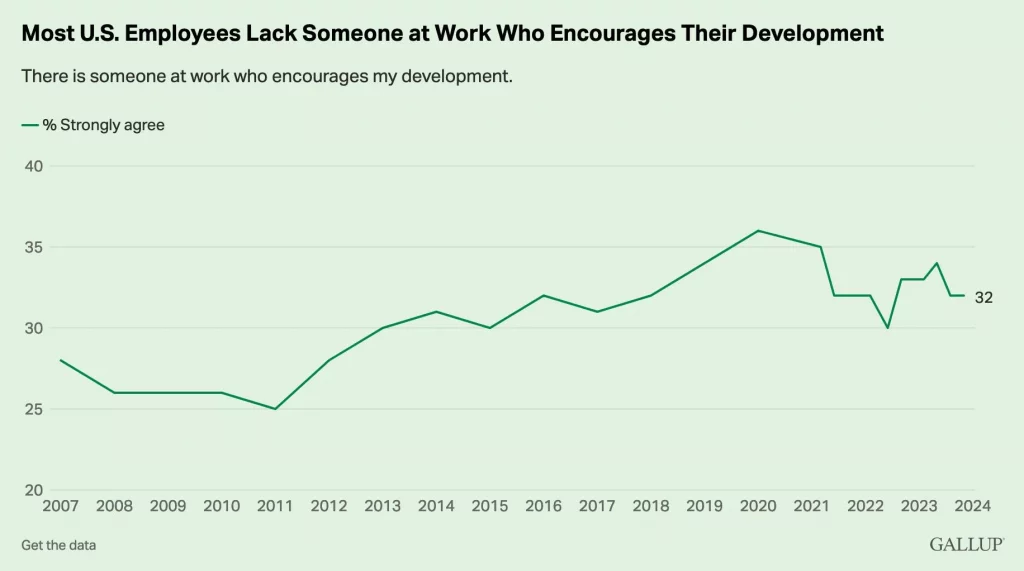
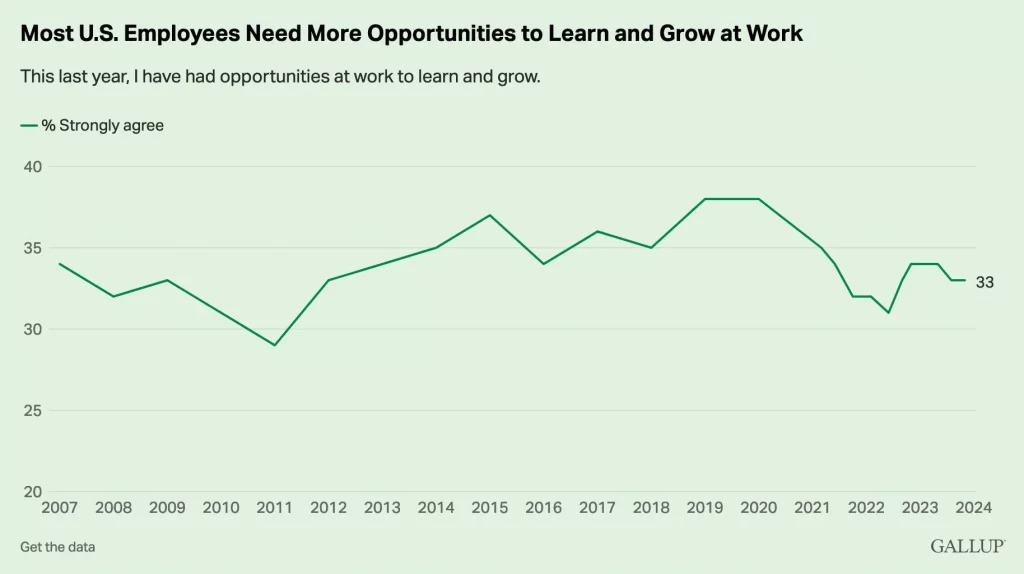
Here again we see a common range over the last 15 years. About 25-35% of employees feel like they're getting help with their career development, and 29-38% have a chance to grow and learn.
You'll also notice in both charts the trend tends to be that when the economy is struggling, career growth tends to drop, while an improving economy creates opportunities and more conversations about careers. The present state shows that once again you can stand out against most managers by encouraging your team members to grow.
Now, in today's economy, that can seem hard; with layoffs, tight budgets, and restricted hiring, there aren't many opportunities for advancement.
Fortunately, there are things you can do. Learn how to grow your team when you can't promote them here.
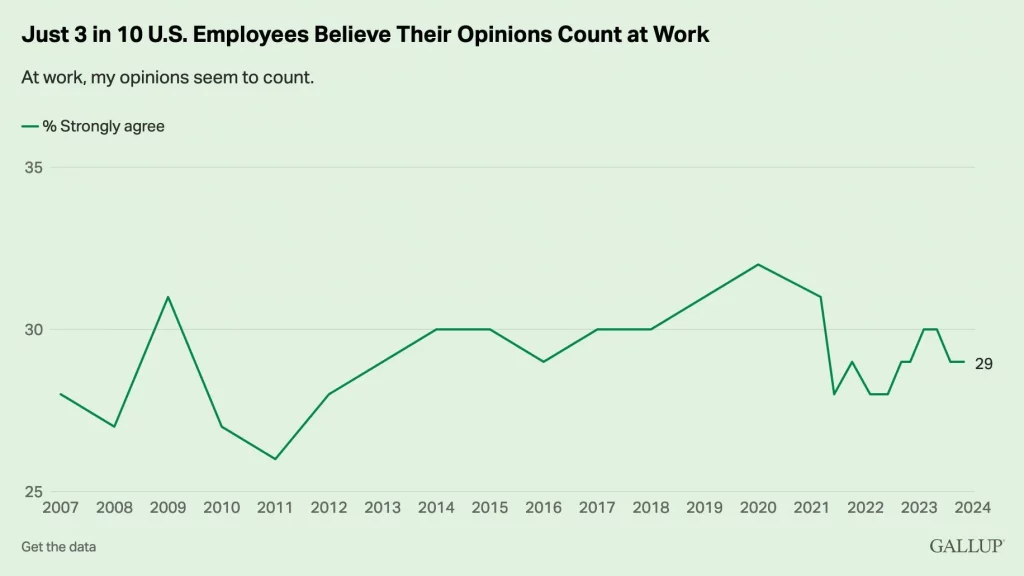
Are you noticing a pattern here? Once again, the range is roughly 25-35% of employees feeling their opinions count at work.
It's not surprising to me.
If you care about your employees, and you help them grow, then you are pretty likely to also value their opinions, which is why this is within range, though slightly less than the prior charts.
Of course, to make your team feel like you value their opinions, using one on ones to ask for those opinions (try these questions) and creating psychological safety can really help you.
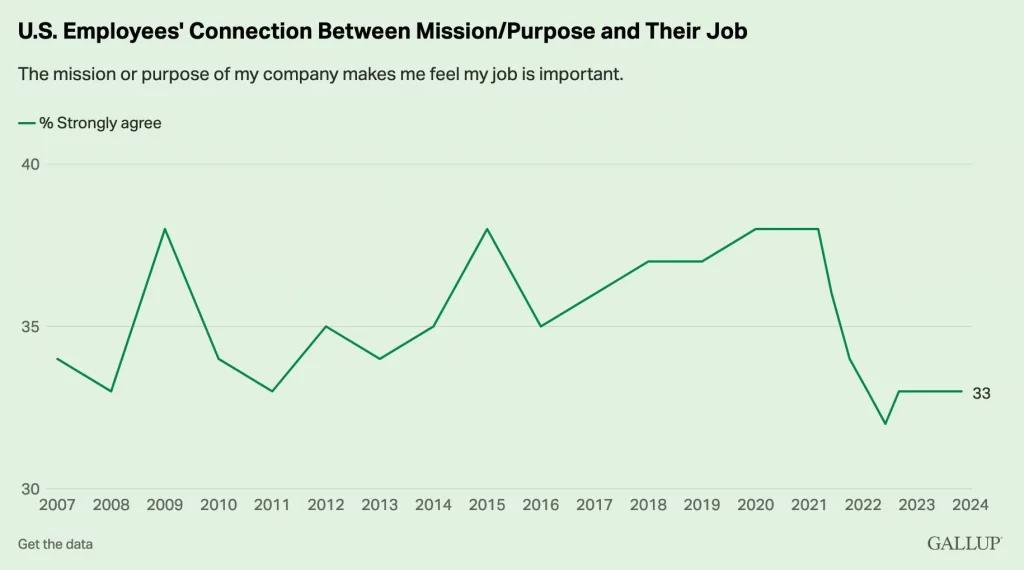
We've talked about this in a few issues before, so I won't belabor the point. However, it's worth noting that since the Pandemic ended, you can see a substantial drop in purpose/mission connection.
I think remote work is to blame for this all time low for mission/purpose.
And that should make sense; if you're isolated to your own work, and not around others day to day, especially senior leadership, it's easy to miss out on a lot of reminders about purpose and mission.
That's why you should proactively talk about it with your team members more than you may have been used to before.

The truth is, people don't make a lot of friends at work.
This number has the least variance of any of the data we've seen, only changing a few percent over the last decade.
That said, it's incredibly powerful, so if you want to understand this power, and tap into it, read more about "Why you should have a best friend at work" here.
--
What do these data points say to you? I hope they give you some food for thought on areas you can work on to stand out as a manager, who then has the best, most engaged, motivated, and productive team.
A quick ask for you to help...
I know many of you have tight budgets right now, so can't financially support this newsletter (but a BIG THANK YOU to those who bought our recent 1 on 1 Master Class course).
However, even if you can't buy a course, you can still support us.
What you can do, which would be a BIG HELP, would be if you would SHARE this newsletter.
Forward it to a friend (or three) and encourage them to sign up. You can copy and paste this message:
"Hi,
I've been really enjoying and learning a lot from this weekly leadership newsletter. Below is the most recent issue.
You should sign up to get it, too here: https://getlighthouse.ck.page/9aa103e62f
Thanks,
It's as easy as that, and helps us reach more leaders like you.
Thanks,
Jason
PS: If you want more insights like this, but through the lens of product management, check out and sign up for my new product management newsletter here.
Sign up to get this newsletter & our latest blog posts straight to your inbox:




